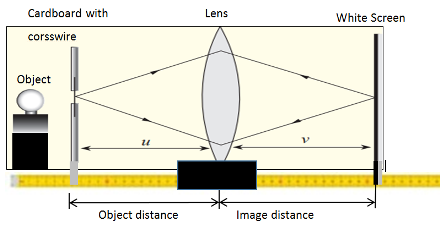Lens formula experiment is a great way to understand the relationship between object distance (u), image distance (v), and focal length (f) of a lens. The mirror describes the relationship that exists between the focal length, image distance and the object distance. By use of mirror formula that had been derived earlier, the unknown focal length of a lens can be determined experimentally. We describe the experiment here and explains how to extract the the focal length from the relationship.
Apparatus
- Meter rule
- lens and a lens holder
- source of light
- screen
- cardboard with a cross wire
procedure to conduct Lens formula experiment
- set the apparatus as shown

- You place the object at the zero centimeter mark
- set the object distance by placing the lens at a reasonable distance from the object like 80cm from the object.
- Adjust the screen until a sharp image is obtained
- Record a distance between the screen and the lens when a sharp image is formed on the screen. That is the image distance.
- Record the image and the object distance
- Reduce the object distance u by about 5 cm and then adjust the screen until another sharp image is formed on the screen.
- reduce the distances distance again by 5 cm and repeat the procedure above.
- Fill the table as shown below

From the data obtained, a graph of 1/u against 1/v can be plotted.
A typical graph will be as shown:

Now the lens formula is stated as:

at the (1/v) intercept, the value of (1/u)= 0
hence :

and hence

and therefore the value of f-1 (1/f) is equal to 1/v.
similarly at the (1/u) intercept, the the value of (1/v) =0
and so the lens formula becomes

hence

from the graph, we can deduce that 1/u and 1/v gives 1/f at the intercepts.
we can get two values of f from the 1/v and 1/u intercepts such that:
f1 = (1/v)-1 and f2 = (1/u)-1
the focal length f is thus the average of f1 and f2 such that

Related Topics
- Focal length by non-parallax method
- Understanding the language of Thin Lens
- Estimating focal length
- focusing a distance object
- The lens formula
- Linear magnification
- Ray diagrams
- Image formation by thin lenses
- Introduction to thin lenses
- Finding focal length by displacement
- Albert Einstein
References:
- Secondary Physics Student’s Book Four. 3rd ed., Kenya Literature Bureau, 2012. pp. 1-42.
- Abbot A. F. (1980), Ordinary Level Physics, 3rd Edition, Heinemann Books International,
London. - Nelkon M. and Parker P., (1987), Advanced Level Physics, Heinemann Educational
Publishers, London. - Tom D., and Heather K. Cambridge IGCSE Physics. 3rd ed., Hodder Education, 2018, https://doi.org/978 1 4441 76421. pp. 106-142.


Leave a Reply